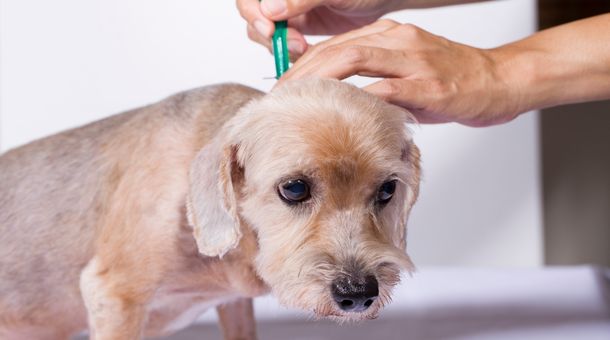You should not use a dog flea collar on a cat. Dog flea collars contain different ingredients than those used in flea collars for cats, and they may be toxic to cats.
The chemicals used in dog flea collars can cause serious harm to cats, including skin irritation, vomiting, diarrhea, seizures, and even death.
Additionally, flea collars designed for dogs may not fit properly on cats, which could cause the collar to become entangled or even choke the cat.
Reasons Why Can’t You Use a Dog Flea Collar on a Cat?

You should not use a dog flea collar on a cat for several reasons. Here are some points to explain why:
Different Ingredients:
Dog flea collars contain different active ingredients than those used in flea collars designed for cats. These ingredients are formulated specifically for dogs and may be unsafe for cats.
Toxicity:
The chemicals used in dog flea collars can be toxic to cats. These chemicals can cause various health problems, including skin irritation, vomiting, diarrhea, seizures, and even death.
Incorrect Dosage:
Flea collars designed for dogs may contain a higher dose of chemicals than those used in flea collars for cats. Using a dog flea collar on a cat could result in an incorrect dosage, leading to serious health issues.
Collar Size:
Flea collars designed for dogs may not fit properly on cats. This could cause the collar to become entangled or even choke the cat.
Ineffectiveness:
Dog flea collars are not designed to protect cats from fleas and ticks. Using a dog flea collar on a cat is unlikely to prevent fleas and ticks from infesting the cat’s fur.
What is the best flea collar for cats?

Here are some top flea collars for cats that veterinarians and pet owners recommend:
Seresto Flea and Tick Collar for Cats:
- This collar is popular for many cat owners because it provides long-lasting protection against fleas and ticks for up to 8 months.
- It contains two active ingredients that kill and repel fleas, ticks, and flea larvae.
- The collar is water-resistant and has a breakaway design to prevent choking hazards.
Hertz Ultra Guard Plus Flea & Tick Collar for Cats and Kittens:
- This collar is an affordable option that provides up to 7 months of protection against fleas and ticks.
- It contains a combination of insecticides that kill fleas and ticks on contact.
- The collar also has a breakaway design for safety.
Bayer Animal Health Seresto Flea and Tick Collar for Kittens:
- This collar is designed for kittens and provides long-lasting protection against fleas and ticks for up to 8 months.
- It is adjustable and has a breakaway design for safety.
Only Natural Pet EasyDefense Flea & Tick Collar for Cats:
- This collar is a natural alternative to traditional flea collars and contains essential oils that repel fleas, ticks, and other insects.
- t is adjustable and provides up to 3 months of protection.
Adams Plus Flea & Tick Collar for Cats:
- This collar provides up to 7 months of protection against fleas and ticks and contains a combination of insecticides that kill and repel fleas and ticks.
- It also has a breakaway design for safety.
What is the safest flea treatment for cats?
Several flea treatments available for cats are safe and effective when used according to the manufacturer’s instructions.
Here are some top flea treatments for cats that veterinarians recommend:
Topical flea treatments:
Topical flea treatments are applied directly to the cat’s skin and are absorbed into the bloodstream to kill fleas and prevent infestations.
- Some popular, topical cat flea treatments include Frontline Plus, Advantage II, and Revolution.
Oral flea treatments:
Oral flea treatments are given to cats in the form of pills or chews and work by killing fleas when they bite the cat.
- Some popular cat oral flea treatments include Comforts, Capstan, and Program.
Flea collars:
Flea collars are worn around the neck of the cat and release chemicals that kill fleas and prevent infestations.
- Some popular flea collars for cats include Seresto and Hertz Ultra Guard.
Flea shampoos:
Flea shampoos are a safe and effective way to kill and remove fleas from the cat’s coat. They can be used in conjunction with other flea treatments for added protection.
- Some popular cat flea shampoos include Adams Plus Flea & Tick Shampoo and Sentry Prescriptions Flea & Tick Shampoo.
How to use a cat, Flea Collar?
Here are the general steps for using a cat flea collar:
Step 1: Choose the right collar
Make sure to choose a flea collar that is designed specifically for cats. Flea collars for dogs may contain chemicals that are harmful to cats.
Step 2: Check for fit
Before putting the collar on your cat, ensure it fits properly. You should be able to fit two fingers between the collar and your cat’s neck, but it should not be loose enough to get its jaw stuck underneath it.
Step 3: Remove the collar from the packaging
Carefully remove the flea collar from its packaging and discard any plastic tabs or covers.
Step 4: Apply the collar
Place the flea collar around your cat’s neck, adjusting the fit as necessary. Be sure to follow the manufacturer’s instructions for how tight to fasten the collar.
Step 5: Trim the excess length
Once the collar is fastened, trim any excess length to prevent your cat from chewing on it or getting it caught on something.
Step 6: Monitor for reactions
Keep an eye on your cat for the first few days after putting on the flea collar to ensure that it has no adverse reactions such as irritation or an allergic reaction.
Remove the collar immediately, and contact your veterinarian if you notice any discomfort.
Step 7: Replace as needed
Flea collars typically protect for several months, but it is important to replace them as the manufacturer recommends to ensure continued protection against fleas and ticks.
A presentation about using cat flea collars:
Here are some precautions to keep in mind when using a flea collar on your cat:
- Choose a flea collar designed specifically for cats.
- Follow the manufacturer’s instructions.
- Monitor your ca
- Remove the collar if necessary.
- Don’t use multiple flea collars.
- Keep away from children.
- Don’t let your cat chew on the collar.
Always consult your veterinarian before starting flea treatment on your cat to ensure it is safe and effective.
Conclusion
In conclusion, using a dog flea collar on a cat is not recommended. The chemicals used in dog flea collars may harm cats, cause adverse reactions, or even be fatal.
Flea collars designed for cats have been specifically formulated with a lower concentration of safe chemicals. Always choose a flea collar that is designed for cats and follow the manufacturer’s instructions carefully.
If you are unsure which flea treatment is safe for your cat, consult your veterinarian before starting any treatment.




